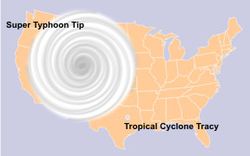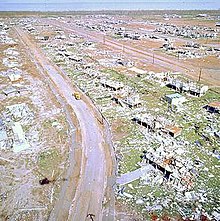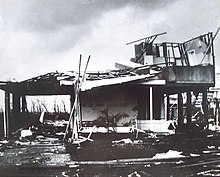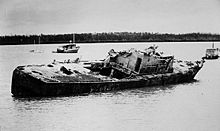This is an old revision of this page, as edited by Ms2ger (talk | contribs) at 12:12, 25 October 2008 (Cleanup). The present address (URL) is a permanent link to this revision, which may differ significantly from the current revision.
Revision as of 12:12, 25 October 2008 by Ms2ger (talk | contribs) (Cleanup)(diff) ← Previous revision | Latest revision (diff) | Newer revision → (diff)| cyclone | |
|---|---|
| Formed | December 21, 1974 |
| Dissipated | December 26, 1974 |
Cyclone Tracy was a tropical cyclone that devastated the city of Darwin, Northern Territory, Australia, from Christmas Eve to Christmas Day, 1974. It was the most compact hurricane or equivalent-strength tropical cyclone on record, with gale-force winds extending only 48 km (30 mi) from the centre; Tropical Storm Marco (2008) may have broken the record for the smallest tropical storm wind field, although it was only a tropical storm at peak strength and the record is yet to be confirmed. After forming over the Arafura Sea, the storm moved upward and affected the city with Category 4 winds on the Australian cyclone intensity scale and the Saffir-Simpson Hurricane Scale, although there is evidence to suggest that it had reached Category 5 when it made landfall.
Tracy killed 71 people, caused $837 million in damage (1974 AUD) and destroyed more than 70 percent of Darwin's buildings. Tracy left homeless more than 20,000 out of the 49,000 inhabitants of the city prior to landfall and required the evacuation of over 30,000 people. Most of Darwin's population was evacuated to Adelaide, Whyalla, Alice Springs and Sydney, and many never returned to the city. After the storm passed, the city was rebuilt using more modern materials and updated building techniques. Bruce Stannard of The Age stated that Cyclone Tracy was a "disaster of the first magnitude ... without parallel in Australia's history."
Meteorological history

Map key Saffir–Simpson scale Tropical depression (≤38 mph, ≤62 km/h)
Tropical storm (39–73 mph, 63–118 km/h)
Category 1 (74–95 mph, 119–153 km/h)
Category 2 (96–110 mph, 154–177 km/h)
Category 3 (111–129 mph, 178–208 km/h)
Category 4 (130–156 mph, 209–251 km/h)
Category 5 (≥157 mph, ≥252 km/h)
Unknown Storm type
 Tropical cyclone
Tropical cyclone  Subtropical cyclone
Subtropical cyclone  Extratropical cyclone, remnant low, tropical disturbance, or monsoon depression
Extratropical cyclone, remnant low, tropical disturbance, or monsoon depression On 20 December, 1974, the United States' ESSA-8 environmental satellite recorded a large cloud mass centered over the Arafura Sea about 370 km (230 mi) northeast of Darwin. This disturbance was tracked by the Darwin Weather Bureau's regional director Ray Wilkie, and by senior meteorologist Geoff Crane. On December 21 1974, ESSA-8 showed evidence of a newly formed circular centre near latitude 8° south and longitude 135° east. The meteorological duty officer at the time, Geoff Crane, issued the initial tropical cyclone alert describing the storm as a tropical low that could develop into a tropical cyclone.
Later in the evening, the Darwin meteorological office received an infrared satellite image from the National Oceanic and Atmospheric Administration's satellite, NOAA-4, showing that the low pressure had developed further and that spiraling clouds could be observed. The storm was officially pronounced a tropical cyclone at around 10 p.m. on December 21, when it was around 200 km (125 mi) to the north-northeast of Cape Don (700 km or 435 mi northeast of Darwin). Over the next few days, the cyclone moved in a southwesterly direction, passing north of Darwin on December 22. A broadcast on ABC Radio that day stated that Cyclone Tracy posed no immediate threat to Darwin. However, early in the morning of December 24, Tracy rounded Cape Fourcroy on the western tip of Bathurst Island, and moved in a southeasterly direction, straight towards Darwin.
By late afternoon, the sky over the city was heavily overcast, with low clouds, and was experiencing strong rain. Wind gusts increased in strength; between 10 p.m. local time and midnight, the damage became serious, and residents began to realize that the cyclone would not just pass by the city, but rather over it. Despite Tracy's small size, the cyclone passed directly over Darwin after midnight, with its eye centered on the airport and northern suburbs. The wind gauge at Darwin Airport officially recorded winds of 217 km/h (135 mph) before being blown away itself. Unofficial estimates suggested that the wind speed had reached 300 km/h (185 mph). The winds and torrential rain continued until early dawn.

Preparations
Darwin had been severely battered by cyclones before; in January 1897 and again in March 1937. However, in the 20 years leading up to Cyclone Tracy, the city had undergone a period of rapid expansion. E.P. Milliken estimated that on the eve of the cyclone there were 43,500 people living in 12,000 dwellings in the Darwin area. Though building standards required that some attention be given to the possibility of cyclones, most buildings were not capable of with standing the force of a cyclone's direct hit.
On the day of the cyclone, most residents of Darwin believed that the cyclone would not cause any damage to the city. Cyclone Selma had been predicted to hit Darwin earlier in the month, but it instead went north and dissipated without affecting Darwin in any way. As a result, Cyclone Tracy took most Darwin residents by surprise. Despite several warnings the people of Darwin did not evacuate or prepare for the cyclone. Many residents continued to prepare for Christmas, and many attended Christmas parties, despite the increasing winds and heavy rain. Journalist Bill Bunbury interviewed the residents of Darwin some time later and recorded the experiences of the survivors of the cyclone in his book Cyclone Tracy, picking up the pieces. Resident Dawn Lawrie, a 1971 independent candidate for the electorate of Nightcliff, told him:
We'd had a cyclone warning only 10 days before Tracy was coming, it was coming, and it never came. So when we started hearing about Tracy we were all a little blasé. (Bunbury, p. 20)
Another resident, Barbara Langkrens, said:
And you started to almost think that it would never happen to Darwin even though we had cyclone warnings on the radio all the time ... most of the people who had lived here for quite some time didn't really believe the warnings. (Bunbury, p. 21)
Impact

Courtesy - National Archives of Australia A6135, K29/1/75/16





Cyclone Tracy killed 71 people, 49 of whom were on land and 22 were out at sea. Two RAN sailors died when HMAS Arrow, an Attack class patrol boat, sank at Stokes Hill Wharf. The storm also caused the substantial destruction of the city of Darwin. The initial estimate put the reported death toll at 65, but it was revised upwards in March 2005, when the Northern Territory Coroner proclaimed that those who still remained listed as missing had "perished at sea".
Several factors delayed the dissemination of the news of the cyclone's impact. The destruction of transportation infrastructure and the distance between Darwin and the rest of the Australian population played a role, as did the fact the storm made landfall on Christmas Day and most media outlets had only a skeleton crew rostered on at best. Most Australians were not aware of the cyclone until late in the afternoon.
In order to provide the initial emergency response, a leadership committee was created. The committee, composed of several high-level public servants and police, stated that, "Darwin had, for the time being, ceased to exist as a city". Gough Whitlam, The Australian Prime Minister, was touring Syracuse at the time but flew to Darwin upon hearing of the disaster. Additionally, the Australian government began a mass evacuation by road and air; all of the Defence Force personnel throughout Australia, along with the entire Royal Australian Air Force's fleet of transport planes, were recalled from holiday leaves and deployed to evacuate civilians from Darwin, as well as to bring essential relief supplies to the area.
Health and essential services crisis
As soon as the worst of the storm had passed, Darwin faced several immediate health crises. On Christmas Day, the Darwin Hospital treated well over five hundred patients, with 112 of these being admitted into the hospital, and both of the facility's operating theatres being utilized. The first casualties did not arrive till 7 a.m. because of high winds and severe road conditions in and around the Darwin area. Operating continued throughout the night and into the early morning. Local teams worked without relief until the arrival of a surgical team from Canberra late that day. Those who were considered unable to return to work within two weeks were evacuated by air to safer locations.
All official communications out of Darwin were no longer operational. The antennas at the Australian Coastal Radio Service station were destroyed during the storm. Station manager Bob Hooper, who was an amateur radio operator, helped to establish communications using his own amateur radio equipment, while several other operators provided message services to the cities of Perth, Melbourne, and Townsville. Soon afterward, VID operators went onboard the MV NYANDA in Darwin harbor and then for five days official communications traffic in and out of Darwin was handled via continuous wave radio.
Those who remained in Darwin faced the threat of several diseases due to much of the city being without water, electricity or basic sanitation. An initial response was to vaccinate residents for typhoid and cholera. Approximately 30,000 people were homeless, and were forced to seek shelter in several makeshift housing and emergency centers that lacked proper hygienic conditions. Volunteers came in from across the country to assist with the emergency relief efforts. Trench latrines were dug; water supplies delivered by tankers, and mass immunization programs begun. The army was given the task of searching houses for the dead bodies of people and animals plus locating other health risks; for example cleaning out rotting contents from fridges and freezers across the city. This was completed within a week. Houses which had been 'searched and cleared' had S&C painted on an external wall. The city itself was sprayed with malathion, in order to control mosquitoes and other similar pests.
Attempts to reconnect the essential services to the city began on Christmas Day. Local officers from the Commonwealth Department of Housing and Construction began clearing debris and working to restore power. They sealed off damaged water hydrants and activated pumps to reactivate the city's water and sewerage systems.
Evacuation and the public response
Major-General Alan Stretton, Director-General of the Natural Disasters Organisation, and the Minister for the Northern Territory, Rex Patterson, arrived at Darwin Airport late on Christmas Day and took charge of the relief efforts. After an assessment of the situation and meetings with the Department of the Northern Territory and the relevant minister, it was concluded that Darwin's population needed to be reduced to a "safe level" of 10,500 people. This decision was made on the advice of Dr Charles Gurd, the Director of Health in the Northern Territory. Around 10,000 people left Darwin and the surrounding area within the first two days, but the rate of departures then began to slow down. The government then gave support to his position, offering full reimbursement of personal costs, as long as the evacuation took place.
The population was evacuated by air and ground transportation; due to communications difficulties with Darwin airport landing was limited to one plane every ninety minutes. At major airports teams of Salvation Army and Red Cross workers met refugees, with the Red Cross taking responsibility for keeping track of the names and temporary addresses of the refugees. Evacuations were prioritised according to need; women, children, the elderly and sick were evacuated first. There were reports of men dressing up as women to escape with the early evacuations. By 31 December only 10,638 people (mostly men who were required to help clean up the city) remained in Darwin. Stretton also regulated access to the city by means of a permit system. Permits were only issued to those who were involved in either the relief or reconstruction efforts, and were used to prevent the early return of those who were evacuated.
Upon receiving news of the damage, several community groups across Australia began fundraising and relief efforts to assist the survivors. Major reception centers were set up in several cites such as Katherine, Tennant Creek and Alice Springs. Several of the small towns along the Stuart Highway made efforts to assist people who were fleeing by road, supplying them with food, fuel, rest, and mechanical aid. At Adelaide River, the small local population provided hot meals to the refugees who stopped there. Approximately twenty-four hours after the storm hit Darwin, the population of Alice Springs had raised well over $105,000 to assist the victims of Tracy. In Melbourne at the Boxing Day Test cricket match, members of both teams moved around the boundaries carrying buckets into which the crowd threw cash into for the relief funds. Darwin families were also given priority on public housing waiting lists. On December 31, 1974, Stretton recommended that full civilian control should resume in Darwin, and handed over control of the city to its elected officials.
Aftermath
Reconstruction and effects on Darwin
In February 1975, Prime Minister Gough Whitlam announced the creation of the Darwin Reconstruction Commission, which was given the task of rebuilding the city "within five years". The Commission was headed by the Lord Mayor of Brisbane, Clem Jones. The damage to the city was so severe that some advocated moving the entire city. However, the government insisted that it be rebuilt in the same location. By May 1975, Darwin's population had recovered somewhat, with 30,000 residing in the city. Temporary housing, caravans, hotels and an ocean liner MV Patris, were used to house people, as reconstruction of permanent housing had not yet begun by September that year.
However, by the following April, and after receiving criticism for the slow speed of reconstruction, the Commission had built 3,000 new homes in the nearly destroyed northern suburbs, and completed repairs to those that had survived the storm. Several new building codes were drawn up, trying to achieve the competing goals of the speedy recovery of the area and ensuring that there would be no repeat of the damage that Darwin took in 1974. By 1978, much of the city had recovered and was able to house as almost the same number of people as it had before the cyclone hit. However, as many as sixty percent of Darwin's 1974 population were no longer living in the city in the 1980s. In the years that followed, Darwin was almost entirely rebuilt and now shows almost no resemblance to the Darwin of December 1974.
Until 1974, the Northern Territory had minimal self-government, with a federal minister being responsible for the Territory from Canberra. However, the cyclone and subsequent responses highlighted several problems with the way the regional government was set up which led to the decision of Malcolm Fraser, Whitlam's successor as Prime Minister, to give self-government to the Territory in 1978.
Many of the government documents associated with Cyclone Tracy became publicly available early in 2005, due to Australian Freedom of Information legislation allowing the declassification of confidential government documents and information after the passage of thirty years.
Cyclone Tracy in popular culture
Cyclone Tracy, due to its severity, has entered into the popular culture of Australia in a way that no other meteorological event has ever before, or has since. Probably the most famous work that it has inspired is the song "Santa Never made it into Darwin" composed by Bill Cate and performed by Bill (Cate) and Boyd (Robinson) in 1975 to raise money for the relief and reconstruction efforts. Subsequently the song became so well-known that in 1983 Hoodoo Gurus released "Tojo Never Made it to Darwin", a song comparing the Japanese bombing of Darwin under the command of Hideki Tojo during World War II to the damage done by Cyclone Tracy. The much feared Japanese invasion never happened, but the cyclone that was virtually ignored ended up destroying the city.
In 1986 the Nine Network and PBL created Cyclone Tracy, a period drama mini-series based on the events during the cyclone. Michael Fisher, Ted Roberts, and Leon Saunders wrote the series, and it starred Chris Haywood and Tracy Mann, who played the lead characters of Steve and Connie.
Australian heavy metal band, Cyclone Tracy, took their name from the tropical disaster.
See also
References
- Publications
- Mckay, Gary (2004). Tracy: The storm that wiped out Darwin on Christmas Day 1974. Crows Nest, Sydney: Allen & Unwin. ISBN 1-86508-558-8.
- Milliken, E. P. (1984). People Who Experienced Darwin Cyclone Tracy: Human Responses in Report on Proceedings of a Research Workshop on Human Behaviour in Australia. National Disasters Organisation, Australian Defence Department.
{{cite book}}: Unknown parameter|month=ignored (help) - "Mr. Whitlam on the spot". The Age. 1974-12-28. pp. 9, 3–5.
- Olds, Margaret (Managing editor); Chan, Gabrielle (Associate editor); et al., eds. (1999). Australia Through Time (7th ed.). Sydney: Random House Publications. p. 441. ISBN 0-09-183815-0.
{{cite book}}:|editor=has generic name (help); Explicit use of et al. in:|editor=(help)CS1 maint: multiple names: editors list (link) - Sea Power Centre - Australia, Royal Australian Navy (December 2004). "SEMAPHORE Issue 14 (occasional series)". Newsletter of the Sea Power Centre - Australia that deals with the Navy's response to Cyclone Tracy.
- Websites
- "Fact Sheet number 176". National Archives of Australia. 2000. Retrieved 2006-07-11.
{{cite web}}: Unknown parameter|month=ignored (help)
- Notes
- ^ "Cyclone Tracey, Christmas 1974". Bureau of Meteorology. 2006. Retrieved 2006-07-11.
- "Bureau of Meteorology - Frequently Asked Questions". Bureau of Meteorology. 2006. Retrieved 2006-03-24.
- "Tropical Cyclone Structure". JetStream. National Oceanic and Atmospheric Administration. 2005-10-19. Retrieved 2006-03-24.
- NHC Hurricane Research Division (2008-01-01). "Atlantic hurricane best track ("HURDAT")". NOAA. Retrieved 2008-10-08.
- ^ "EMA Disasters Database - Tropical Cyclone Tracey". Emergency Management Australia. 2005-05-29. Retrieved 2006-07-07.
- "Meteorological Cyclones Information - Countdown to the impact of Cyclone Tracey". Northern Territory Library. Retrieved 2006-07-11.
- "Meteorological Cyclones Information - Warnings issued for Cyclone Tracey". Northern Territory Library. Retrieved 2006-07-11.
- ^ "Fact Sheet number 176". National Archives of Australia. 2000. Retrieved 2006-07-11.
{{cite web}}: Unknown parameter|month=ignored (help) - "Previous cyclones in Darwin - Cyclone Tracey". Northern Territory Library. Retrieved 2006-07-11.
- ^ Bunbury, Bill (1994). Cyclone Tracy, picking up the pieces. Fremantle, Western Australia:: Fremantle Arts Centre Press. ISBN 1-86368-112-4.
{{cite book}}: CS1 maint: extra punctuation (link) - ^ "NT coroner hands down finding on Cyclone Tracy deaths". Australian Broadcasting Corporation. 2005-03-18. Retrieved 2006-03-24.
- "National Archives of Australia Fact Sheet 176". National Archives of Australia. 2000-09-01. Retrieved 2006-07-07.
- "Australasian Performing Right Association". Retrieved 2008-01-10.
- Bill Cate. "Santa Never Made it into Darwin". Retrieved 2006-03-24.
External links
Listen to this article(2 parts, 18 minutes)
- Cyclone Tracy newsreel
- Northern Territory Library on Cyclone Tracy
- Collected oral histories of Cyclone Tracy
- Houses destroyed by Cyclone Tracy, Darwin, December, 1974 (picture) / Alan Dwyer.
- Meteorological Information
- Weather satellite image of Tropical Cyclone Tracy 25 December 1974 (9.55am Darwin time, 0025 Greenwich Mean Time), over Darwin, Northern Territory, from NOAA 4.
- Records about Cyclone Tracy from the Australian Bureau of Meteorology
- Addional Information on Cyclone Tracy
- Australia Broadcasting Corp. Rewind on Cyclone Tracy